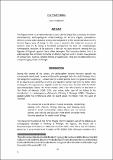Files in this item
The Pygmy mimic
Item metadata
| dc.contributor.author | Frankland, Stan | |
| dc.date.accessioned | 2016-02-24T10:10:07Z | |
| dc.date.available | 2016-02-24T10:10:07Z | |
| dc.date.issued | 2016-08 | |
| dc.identifier | 241204445 | |
| dc.identifier | 763d12f0-ee63-4a41-b16d-bba4b0e76e04 | |
| dc.identifier | 84977485287 | |
| dc.identifier | 000388178700007 | |
| dc.identifier.citation | Frankland , S 2016 , ' The Pygmy mimic ' , Africa , vol. 86 , no. 3 , pp. 552-570 . https://doi.org/10.1017/S0001972016000371 | en |
| dc.identifier.issn | 0001-9720 | |
| dc.identifier.other | ORCID: /0000-0003-1943-5218/work/90111999 | |
| dc.identifier.uri | https://hdl.handle.net/10023/8292 | |
| dc.description | The author thanks the Universities of St Andrews and London, the Economic and Social Research Council, the Horniman and Swan Funds, and also the Carnegie Trust. | en |
| dc.description.abstract | The Pygmy mimic is an extremely persistent colonial trope that continues to inform contemporary anthropological understandings of Africa’s Pygmy populations. Mimicry is now understood as being a key component of the social reproduction of a distinct Pygmy way of being. In this paper I examine the historical accounts of mimicry and try to bring a historical perspective to bear on contemporary ethnographic accounts of its practice. I also set my own research among the Sua Pygmies of Uganda against these other examples. The intention behind this is to acknowledge the common humanity of Africa’s Pygmies and to create new grounds of comparison - such as a shared history of oppression - that are not dependent on a unique foraging mode of thought. | |
| dc.format.extent | 19 | |
| dc.format.extent | 527642 | |
| dc.language.iso | eng | |
| dc.relation.ispartof | Africa | en |
| dc.subject | GN Anthropology | en |
| dc.subject | BDC | en |
| dc.subject | R2C | en |
| dc.subject.lcc | GN | en |
| dc.title | The Pygmy mimic | en |
| dc.type | Journal article | en |
| dc.contributor.institution | University of St Andrews. Social Anthropology | en |
| dc.identifier.doi | https://doi.org/10.1017/S0001972016000371 | |
| dc.description.status | Peer reviewed | en |
This item appears in the following Collection(s)
Items in the St Andrews Research Repository are protected by copyright, with all rights reserved, unless otherwise indicated.

